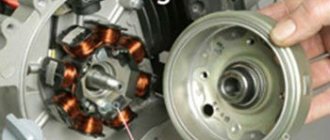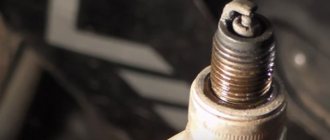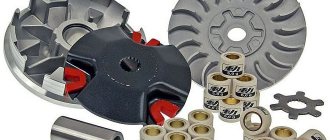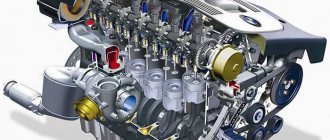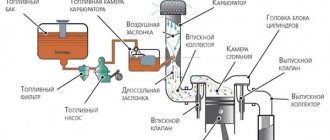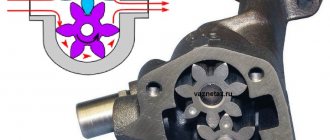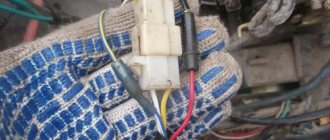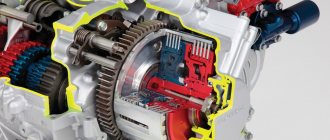A variator is one of the main components of a scooter's transmission. The main task facing the variator is to provide the required speed mode. As a rule, one of the most popular variators is considered to be V-belt. The quality of the CVT directly depends on the number of engine revolutions. The operating principle of CVTs is very simple, especially in comparison with a manual transmission. In addition, in the event of a breakdown, repair work is several times cheaper compared to a manual gearbox.
CVT components
The scooter has a small weight and dimensions (compared to motorcycles and cars), respectively, and the gearbox should be small.
From the automobile, the scooter's variator inherited:
- two pulleys - driving and driven (although here they are wedge-shaped, and each consists of two halves);
- belt (its shape is trapezoidal, unlike a car belt).
That's all the legacy.
The position of the wedge-shaped halves (cheeks) of the drive pulley is regulated by rollers. The opening and closing of the driven pulley cheeks is carried out by a central spring connected to the clutch.
How does a scooter's CVT work?
Since the V-belt variator is the most commonly used design that is installed on a scooter, the design of this type of variator will be described below.
The scooter's CVT is designed in such a way as to provide an automatic continuously variable transmission. A scooter's variator consists of drive and driven pulleys and a V-belt. The cross-section of the belt has the shape of a trapezoid. The drive pulley is a small cone-shaped part that has two halves (cheeks). One cheek is motionless. It is screwed to the journal (tail) of the crankshaft with a bolt and washer. The second cheek of the pulley rests on special rollers and moves along the shaft with their help. The rollers, in turn, rest against the stationary cheek of the drive pulley. The driven pulley has the same structure as the driving one. However, instead of rollers, a spring is installed on it.
A scooter's variator, the design of which may differ slightly in different models of motor vehicles, is much simpler than a standard manual or automatic transmission. Its replacement and repair will cost much less than classic manual and automatic transmissions. In addition, when driving a scooter with a variator, the driver practically does not participate in changing gears, since the operation of the variator depends on the number of revolutions of the engine itself.
More about the operating principle
So... The scooter is started and idling. What happens in the variator? The drive pulley rotates at minimum speed. The strap is located just above the center of the cheeks. The slave's cheeks are compressed by a central spring. The belt on them moves along the maximum radius.
The scooter started moving. It's worth mentioning the videos here. They are located behind the inner cheek of the drive pulley. When the speed of rotation of this pulley increases, centrifugal force pushes the rollers towards the outer radius, thereby pressing the halves of the drive pulley together. The belt between these halves moves outward - the radius of its rotation on the leading cheeks increases.
The driven pulley acts exactly the opposite. During acceleration, a centrifugal force acts on it, just like on the rollers, with the help of which the cheeks move apart, compressing the central spring and passing the belt between them. This is how acceleration happens.
Due to this synchronous operation of the pulleys, speed increases at constant speed and maximum engine power.
How does a scooter's CVT work?
To understand the principle of operation of a scooter's variator, you need to imagine a system for changing gear ratios in a regular bicycle: sprockets at the front and rear, and a chain between them. The role of sprockets in a scooter's variator is played by pulleys (driver and driven), and the role of the chain is played by a trapezoidal belt. The pulley cheeks can move closer and further away from each other, due to which the position of the variator belt changes. The closer the pulley cheeks, the closer the belt is to the axis of the pulleys (inside), the further away, the closer the belt is to the outer edge of the pulleys (outside). If the belt is very close to the axis of the pulleys, the radius along which it moves is small. The radius of movement of the belt is also called the working radius of the variator.
A variator on a scooter, the operating principle of which is quite simple, operates according to the following mechanism: if the working radii of both pulleys are the same, they rotate at the same speed; if you rotate a pulley with a larger working radius faster, then a pulley with a smaller working radius will also rotate faster.
As engine speed increases (as vehicle speed increases), the drive pulley compresses and the driven pulley moves apart. This leads to the fact that the gear ratio changes. It is worth noting that the radii of both pulleys always change synchronously.
In order for the scooter to work properly and speeds to switch smoothly, it is necessary to properly configure the variator. This can be done manually or using special tools. In order to adjust the scooter's variator, it is best to contact an experienced technician. He will not only adjust the gear mechanism, but also perform a preventive inspection and repair of the entire transmission. Proper operation of the variator and transmission will not only extend the life of the scooter, but also prevent a possible accident.
Setting up a variator on a scooter
By adjusting the variator, the desired dynamics of the scooter are achieved. It can be improved by replacing both the factory rollers and the spring.
The operation of the rollers on a scooter's variator depends on their weight. The manufacturer selects the optimal one when assembling the box. But those who like to drive fast change them to heavier ones. With weighted rollers, a scooter with a variator accelerates more slowly at the start, but after reaching maximum speed, the engine produces a speed 10-15 km/h higher than with factory rollers.
Using rollers of less weight leads to the opposite principle: the scooter starts sharply, but it is difficult for it to reach maximum speed.
Changing spring stiffness also affects speed. Stretched and weak, it will not be able to tightly press the cheeks of the driven pulley. This will cause the belt to constantly operate at a smaller radius than necessary. A spring that is too stiff, on the contrary, will not allow you to reduce this radius (correspondingly increase the speed of the driven pulley) and develop the maximum speed of the scooter.
The design and principle of operation of a scooter variator
What is a variator? A CVT is a mechanical continuously variable transmission. It is used to smoothly change the rotation speed of the driven shaft. Basically, all types of scooters have a V-belt variator. It consists of a drive pulley, a driven and a V-belt and works only depending on the number of engine revolutions, without reacting to loads (for example, when going uphill, the load on the rear wheel increases, but the gear ratio remains unchanged), which is one of its disadvantages .
Let's start with the simplest. Why V-belt? From the picture on the left you can see that the belt in section has a trapezoidal shape and is “wedged” into the pulley only with its side surfaces. When these surfaces wear, due to their shape, it cuts deeper into the pulley and still remains in good adhesion to it.
How does the gear ratio change? The design of the drive pulley (the drive pulley is rotated by the crankshaft) is such that its cheeks, when exposed to centrifugal forces, smoothly compress and push the V-belt further and further from the center of the pulley. The driven pulley, on the contrary, unclenches, and the belt on it smoothly sinks closer and closer to the center of the pulley. The higher the engine speed, the more the drive pulley compresses and the driven pulley expands, thereby changing the gear ratio from the crankshaft to the rear wheel. This process is clearly visible in these figures:
The engine is not running.
Low engine speed.
Average engine speed.
Maximum engine speed.
The figures also show the positions of the V-belt in a section on the drive pulley (left) and driven pulley (right) under different engine operating modes.
How is the drive centrifugal pulley of the variator arranged? Quite simple!
Let's look at its design, shown in the figure:
Drive centrifugal pulley of the variator.
1 - fixed pulley cheek, rigidly screwed to the trunnion (tail) of the crankshaft 5 with a bolt 8 with washer 6. V-belt 2 is placed between cheeks 1 and 3. Cheek 3 is designed so that it moves freely on shaft 5. It is moved by rollers 4 that rest into the persistent and stationary cheek 9. Under the influence of centrifugal force, the rollers 4 diverge from the center of the shaft 5, thereby moving the cheek 3 closer to the cheek 1 and pushing the belt 2 further from the shaft 5. The positions of the rollers 4 and cheeks 3 at different engine speeds you already seen in the four pictures above.
Now a little about the driven pulley (picture below).
Driven pulley.
It differs from the drive pulley in that it does not have rollers, but instead a spring (see picture on the right). At the moment when the cheeks on the driving pulley come together, pushing out the belt, on the driven pulley the cheeks (namely, the cheek 5 moves along the shaft 7, the cheek 6 is installed rigidly and motionless), on the contrary, they diverge, compressing the spring 3, and the belt drops deeper, which again, it can be seen in the engine operating modes above in four figures. Thanks to spring 3, the V-belt is always tensioned, and its tension increases proportionally with increasing speed. This in turn allows the belt to not slip at higher speeds, at which the load is greater than at lower speeds.
There are also simpler models of scooters that do not have a variator on the drive shaft. Instead, a simple pulley is installed and the gear ratio from it to the driven one is fixed at all engine speeds. Such models exceed 50 km/h. do not develop and “stupidly” gain momentum from a standstill. Their driven pulley is the same as that of CVTs - under a spring and serves only to tension the belt. The only advantage of this device is that the belt lasts longer.
Then the automatic clutch, which is assembled with the driven pulley, comes into operation.
Good luck!
Source: www.moto.com.ua
Repair of a variator on a scooter. Replacing elements
A change in acceleration speed and the appearance of extraneous noise in the variator indicate that some part (or parts) are worn out and require replacement.
To find out the cause of the malfunction, you should disassemble the variator:
- Remove the cover. We do this carefully so as not to damage it. As a rule, the variator cover on scooters has a sealing gasket. It is necessary to evaluate its condition and, if necessary, change it.
- To remove the belt from the variator, you need to remove the drive pulley. And you can get to it only by removing the retaining ring, clutch and gear.
- When the belt and pulley halves are ready, remove the rollers.
- All items must be carefully inspected and tested. Serviceable cheeks have a smooth surface without chips or burrs. The presence of any lubricants on the belt is excluded. If it looks shabby, then it's time to change it.
- After identifying faults, we assemble the variator in the reverse order.
There are two main signs by which the quality of the variator is determined: belt movement and engine speed. In a working variator, the belt does not slip in the pulleys. But, if the engine roars and the scooter does not move, this is the first signal that it is time to look inside the device and examine the condition of the belt and spring.
The operating speed of the engine must correspond to the speed of its maximum power. If this does not happen, it’s time to start adjusting the operation of the variator.
What is a scooter's CVT?
A CVT on a scooter is like a gearbox in a car. This part is an important component of a motorcycle engine, which is used in the transmission. A variator on a scooter is needed in order to set the required speed limit while the vehicle is moving.
There are two types of variators:
- front;
- rear
There are also cast and composite variators. Engineers have developed many types of designs for these parts, but V-belt variators are most often used in scooters.
16.40. Scooter repair. Centrifugal clutch - removal and installation, replacement of pads
16.40. Scooter repair. Centrifugal clutch - removal and installation, replacement of pads
An assistant will be required to complete the work.
The variator cover is removed, the V-belt is removed (see Variator belt - replacement).
REMOVAL
1. Unscrew the driven pulley nut. This nut is tightened with a fairly large torque, so in order to unscrew it, you need to fix the pulley. It is best to use a special stopper, which is easy to make yourself, or simply insert a metal rod of suitable length between the clutch drum hole and the surface on which the scooter is installed. We put the spanner on the nut, lightly use a hammer to loosen the nut and unscrew it.
2. Remove the clutch drum from the shaft.
3. Remove the driven pulley assembly with the clutch block.
4. Inspect the clutch pads for wear and mechanical damage. It is necessary to make sure that the friction material of the pads has no mechanical damage, chips, deep scratches, and that the adhesive connection between the friction material and the pads is not damaged. If such damage is present, the pads must be replaced.
5. Measure the thickness of the friction layer on the pads. If the thickness is less than the minimum allowable specified by the scooter manufacturer (usually about 1 mm), the pads must be replaced
It is also important that the thickness of the friction layer on all pads is the same, and wear is uniform over the entire area of the lining
6. In order to separate the clutch assembly from the driven pulley, it is necessary to unscrew the central nut. To loosen the nut, it is necessary to clamp the assembly in a vice.
ATTENTION!
To avoid damaging the friction material of the pads, you should clamp the assembly in a vice with the minimum necessary force and use aluminum jaws or spacers made of any soft metal.
When holding the assembly in a vice, do not unscrew the nut completely, but only loosen it. Otherwise, the compressed spring, which is located inside the mechanism, will “shoot” and may cause injury.
7. We ask an assistant to firmly press the clutch to the pulley, as shown in the photo, and unscrew the nut. After this, the assistant gradually loosens his hands, allowing the spring to slowly unclench.
8. Remove the clutch assembly and spring from the pulley.
9. We inspect all parts for external damage. It is necessary to make sure that the halves of the driven pulley rotate freely, without jamming, relative to each other (in the driven pulley, as a rule, the halves are connected according to the “groove-key” principle. A bushing is rigidly attached to one of the pulley halves, on which the second half of the pulley rotates freely. Its movement is limited only by the oblique groove in which the key slides. It is this mechanism that ensures that the distance between the pulley halves changes when one half rotates relative to the other). If the sliding surface of the bushing is dirty, it is necessary to wash it with carburetor cleaner, kerosene or nitro paint solvent, and then lubricate it with penetrating silicone grease or engine oil.
It is also necessary to remove belt wear products (rubber dust) and clutch linings from all parts.
10. The clutch is ready to replace the pads.
11. Using narrow pliers, remove the retaining rings from the guide blocks.
12. Remove the pressure plate.
13. Lightly tap the center of the base of the assembly with a hammer handle to knock it out of the block package.
ATTENTION!
At the base of the unit, rubber dampers are installed under the pads. Once the pads move, the dampers may fall out. The dampers must be removed.
14. Remove the package of pads from the base.
15. Remove the springs connecting the pads and disassemble the pad package.
ATTENTION!
All springs in the clutch mechanism are calibrated. They are not allowed to be stretched, compressed or changed in shape. The springs connecting the pads must be of the same stiffness (usually the springs are color coded).
16. Before assembly, clean the clutch pad axles from dirt and old grease, and apply a thin layer of high-temperature grease to them.
ATTENTION!
Lubrication must be done carefully; after installing new pads on the base, remove excess lubrication. Contact of lubricant on the working surfaces of the pads is unacceptable.
INSTALLATION
Install the clutch in reverse order.
ATTENTION!
After installing the retaining rings on the axle, you need to rotate them so that the cuts of the rings are directed outward. This is necessary in order to protect them from spontaneously jumping off the axles under the influence of centrifugal force.
Next chapter
info.wikireading.ru
Variations on the handle
So, with the general principles of changing the gear ratio everything should be clear, now it’s time to proceed to the mechanism of this change, that is, how to make the scooter’s variator pulleys move and move apart exactly when required. To do this, let’s immediately make a reservation that in a scooter variator it is customary to distinguish the driving pulley (located on the crankshaft) and the driven pulley (located on the clutch shaft). In the bowels of the drive pulley there are special cylindrical weights (sometimes also called rollers). These plastic-coated metal bushings are placed in special grooves in which they can move radially. If you move the weights in the drive pulley from the center outward, they will inevitably move the pulley cheeks together. In fact, of course, only one cheek of the variator pulley moves, but this is not important. When the pulley rotates, the weights, under the influence of centrifugal force, tend outward and, shifting the pulley cheeks, push the belt outward. The faster the pulley rotates, the stronger the centrifugal force acting on the weights, and the further outward the compressing pulley cheeks will push the belt. The driven pulley has no weights, but has a large spring that constantly tries to squeeze its jaws together and push the belt out. Like the driving pulley, the driven one has only one moving part - the external one (referred to in foreign literature as the torque driver). It is the torque driver that moves either outward, overcoming the resistance of the spring and allowing the belt to “fall” inside the pulley, or, conversely, inward, closer to the fixed part of the pulley. Thus, the change in the working radii of the scooter's variator pulleys always occurs synchronously. When the belt goes out in the driving pulley, then in the driven pulley, overcoming the resistance of the spring, the belt, on the contrary, moves inward, closer to the axis of the variator pulley.
For a more complete understanding of the process, let's see how the scooter's variator behaves under different engine operating modes . At idle, the rotation speed of the variator drive pulley is minimal. Although a certain centrifugal force acts on the weights, it is not enough to pull the belt out. After all, this requires overcoming the resistance of the large spring of the driven pulley! But now the gas is open, the crankshaft speed jumps, and now the centrifugal force acting on the weights is already enough to push the variator belt in the drive pulley a little outward.
Drive pulley coupling: cover; guide plate; coupling body; rollers.
The gear ratio changes. The rotation speed of the driven pulley of the variator increases significantly, which forces the centrifugal clutch to operate. The scooter starts moving. The engine speed reaches its operating level, meanwhile the belt continues to move further and further outward in the drive pulley of the variator, and deeper in the driven pulley. That is, the speed remains unchanged, but the gear ratio gradually changes, making the scooter go faster and faster. This, by the way, hides one of the great advantages of the variator - acceleration occurs at constant speeds, so you can configure the entire system so that during acceleration the engine will operate at its maximum power (for example, this is impossible to achieve with a manual transmission). Finally, the belt reaches its maximum design radius in the drive pulley of the variator, and its minimum in the driven pulley. However, as a rule, it is possible to accelerate a little faster, but by increasing the speed of the scooter's engine, and not by increasing the transmission.
When the throttle is closed while driving, the engine brakes the scooter for some time until the centrifugal clutch disengages. As soon as it is turned off, under the action of the large spring of the driven pulley, the belt returns to its original position, as when idling a scooter. But as a rule, the scooter’s clutch disengages only when it comes to an almost complete stop (10 - 25 km/h).
By the way, about the scooter’s clutch. This device, although it performs independent functions, is very closely connected with the scooter’s variator itself: if the clutch does not work correctly, the variator will not work correctly, and vice versa. A scooter's centrifugal clutch is almost always three drum-type brake pads that are pushed outward by centrifugal force and engage the clutch drum. The clutch assembly itself is mounted on the driven pulley of the variator and rotates, but the clutch drum is on a shaft, which transmits torque to the rear wheel through a simple gearbox. Thus, in order to make the scooter move, you need to make the clutch drum rotate. This happens as soon as the driven pulley of the scooter's variator gains sufficient rotation speed so that the centrifugal force becomes large enough for the pads to overcome the elastic force of the clutch springs, which prevents their free movement outward. These same springs will “disengage” the clutch, squeezing the pads together when the rotation speed of the driven pulley drops below the critical level for the clutch to operate. As you can see, the system is simple. And it works almost flawlessly, reducing control of the power unit to twisting the throttle (hence, by the way, the name of one popular scooter magazine: Twist'n'go - “Twist and Ride!”). Which not least determined the current wave of popularity of scooters.
This video shows the CVT in action. Shown in the best possible way.
There are several parameters that determine the correct operation of the variator and indicate its good tuning. Firstly, the belt should not slip in the pulleys. Minimal slippage there, of course, is inevitable, but it should be such that the scooter owner does not notice it. Slipping of the variator belt is doubly harmful to the scooter transmission. This includes a decrease in efficiency and increased wear of parts (belt slippage in the drive pulley can also lead to the plastic shell of the variator weights melting due to overheating). A characteristic symptom of slippage is a rise in engine speed when starting from a standstill, which is not accompanied by the expected acceleration (“roars, but does not go”). What determines the slippage of the variator belt? First of all, from the stiffness of the large spring of the driven pulley. The stiffer the spring, the more tension the belt will have before it moves outward in the drive pulley of the variator, and therefore the less it will slip. However, the spring stiffness should not be excessive, otherwise the maximum speed will drop. There are other factors that also affect belt slippage. This is, for example, its wear and tear. Here, of course, there is only one method of struggle - timely replacement.
Limiters in the variator
This can be either a restrictive ring between the cheeks of the variator, or a plate screwed to the variator on the side where the weights are installed (depending on the engine model). Both of these plugs have the same purpose, namely, to prevent the variator cheeks from shrinking completely. Thus, the belt does not reach its maximum radius. Those. travel speed is limited. Reaching, for example, 45-50 km/h, the scooter does not accelerate further, while the crankshaft speed increases. On the other hand, to prevent the engine from breaking down due to too high speeds, a limiter is installed in the switch. The idea is that when a certain number of engine revolutions is reached, the ignition of the fuel stops. We will talk about this later, but for now – the variator.
We disassemble the variator, remove the gear and belt. Here it is, the restrictive ring.
Just remove this ring and you can put everything back together. If there is no ring, then remove the inner cheek of the variator. A thrust plate can be screwed on from the inside, and there are weights under it.
Unscrew this plate
and put everything in place (no need to put the plate in!).
This is what the variator should look like after removing the restrictor plate
If it happens that neither the plate nor the ring is installed in the variator, then pay attention to the bushing. It may have a protrusion that acts as a ring
There are two options: You buy a new bushing or look for a turner who will turn it. The main thing is not to oversharpen! The surface must then be sanded. We put everything in place and assemble the variator.
Radius run
A more correct formulation for the technical characteristics of the scooter transmission would be the following: “automatic continuously variable.” In fact, we are talking about such a type of transmission as a V-belt variator , which appeared quite a long time ago, but due to its characteristics, it received the greatest development on scooters, as well as on snowmobiles.
The design of such a transmission is much simpler than a classic manual gearbox, and even more so than the notorious “automatic machines” that cars are equipped with (by the way, some representatives of the four-wheeled world also have a CVT, but a different one than on scooters). It is very simple to understand how a variator works if you remember the system for changing gear ratios on bicycles: several sprockets in front, several in the back, and they are connected by a chain.
True, the V-belt variator does not have any sprockets, but there are two pulleys of V-shaped cross-section, consisting of two cone-shaped halves . These halves, called cheeks, can move closer to or further away from each other. The pulleys are connected by a flexible variator belt , which has the cross-sectional shape of an isosceles trapezoid. Depending on the position of the pulley cheeks relative to each other, the belt in the variator pulley can be either closer to the pulley axis (inside) or closer to the outer edge of the pulley (outside). The closer the belt is to the pulley axis, the smaller the radius along which the belt runs, or, as they say, the working radius of the variator pulley. Now let's imagine a system of two pulleys and a belt in action. If the “working radii” of each pulley are the same, then when one rotates, the other will rotate at exactly the same speed. If we rotate a pulley whose working radius is larger, then the other one (whose radius is smaller) will rotate faster. Here it’s time to remember “bicycle sprockets” again; it’s just that in a variator, a larger sprocket corresponds to a larger working radius of the pulley, and a smaller sprocket corresponds to a smaller radius.


